Many times, students push corporate professionals to do more and think outside the box, as they did in my last guest post Students Help Local Utility Embrace Electric Vehicles. Sometimes, campuses can benefit from the time and money that for-profit companies have invested in testing sustainability solutions in the marketplace. In coaching campus sustainability clubs, I have been able to share the lessons we learned at Kum & Go, taking the company from zero recycling options for customers at-the-pump to over 112 stores in three years. I am certain that story can benefit any campus, whether just starting out or with a robust recycling program they want to take to the next level.
A Convenient Comparison
From 2010 to 2014, I was the manager of sustainability for an award-winning convenience store (c-store) chain, Kum & Go, headquartered in West Des Moines, Iowa. During that time, we became the first and only c-store in the world to be certified in the Leadership in Energy & Environmental Design (LEED) Volume Program. During my tenure, we went from two to over 84 certified “green” buildings, including: 8 Gold and 35 Silver level certification – no Platinum, yet.
Among our other sustainability accomplishments, I worked on: fuel safety, low-impact landscaping, water conservation, energy efficiency, solar power, employee volunteerism, and charitable giving. Recycling was a critical component, which I’ll discuss at length.
How does this relate to university sustainability programs?
One thing I learned, is that our customers are busy. Like college students, they were often too busy to pay attention to things like which bin was recycling or any signage about sustainability. Research showed the average of 800 visitors to our stores per day spent an average of only 3 minutes on our property. 3 minutes. Our observations uncovered that they rarely looked at anything besides the gas pump, the snacks they were buying or the cash register. We put large LEED clings on the entry doors of our certified buildings once, and watched customers walk inside for a few hours. They stared at the ground, back at their vehicle, or peered inside the door through the glass. It was so frustrating, but also humbling to realize why the clings were not a good investment.
In short, people are in a hurry. The convenient thing about stopping for fuel or snacks was also the root cause of why visitors would not separating recycling well – leaving us with high levels of contamination. Campuses are no different. Perhaps, students are even less difficult to plan for than c-store customers. And so, it was no surprise that what we learned over those 3 years of research at Kum & Go about recycling is beginning to prove beneficial to college campuses.
Three Year Journey in a Few Words
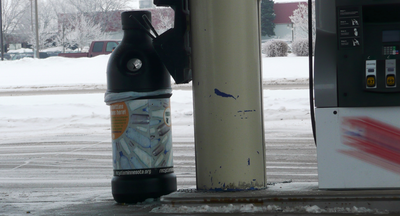 Here is a brief history of how recycling went at Kum & Go: In 2010, upon getting hired, we scheduled waste audits at dozens of stores in multiple states. Then, we went in search of any c-store in the US that was doing recycling well. Only one was found: a Holiday in Owatonna, Minnesota. I scheduled a road trip with a few co-workers and we drove three hours north. There, we saw a program being run by the Recycling Association of Minnesota (RAM) with Holiday as the host. So, we contacted and toured their facility instead, where they were providing jobs to adults with disabilities – both in the pickups and sorting of materials. Pretty cool.
Here is a brief history of how recycling went at Kum & Go: In 2010, upon getting hired, we scheduled waste audits at dozens of stores in multiple states. Then, we went in search of any c-store in the US that was doing recycling well. Only one was found: a Holiday in Owatonna, Minnesota. I scheduled a road trip with a few co-workers and we drove three hours north. There, we saw a program being run by the Recycling Association of Minnesota (RAM) with Holiday as the host. So, we contacted and toured their facility instead, where they were providing jobs to adults with disabilities – both in the pickups and sorting of materials. Pretty cool.
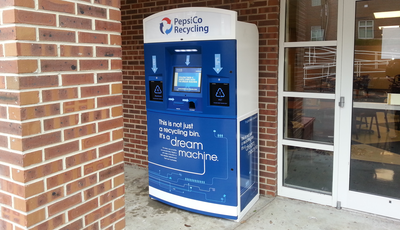 We tried the bottle-shaped recycling bin they were using at a pilot location in Ankeny, Iowa in partnership with Waste Management. We also were awarded a grant, where we partnered with RAM to create a similar jobs program, but this time in three Colorado urban communities. We partnered with PepsiCo Recycling at the same time, to pilot nine rural Colorado locations with their Dream Machine™ outdoor reverse-vending machine (like a Redbox for recycling). Go big or go home, I guess.
We tried the bottle-shaped recycling bin they were using at a pilot location in Ankeny, Iowa in partnership with Waste Management. We also were awarded a grant, where we partnered with RAM to create a similar jobs program, but this time in three Colorado urban communities. We partnered with PepsiCo Recycling at the same time, to pilot nine rural Colorado locations with their Dream Machine™ outdoor reverse-vending machine (like a Redbox for recycling). Go big or go home, I guess.
The Ankeny location proved that, with a passionate manager and engaged employees, we could see a cost-savings from recycling. We were able to go from one recycling dumpster and three trash dumpsters picked up per week, to three recycling dumpsters and one trash dumpster per week. The store’s diversion completely flipped their waste profile, and the good ROI encouraged leadership to expand of the program.
In Colorado, the urban locations were complex. We needed to find an existing jobs program for special needs adults that wanted to expand to provide the whole community with recycling – not just our convenience stores. It was new for our corporate culture to think about launching a community initiative that would also benefit our competitors, but recycling isn’t something we wanted to keep to ourselves. The first success was in Greeley, Colorado with Schaefer Enterprises.
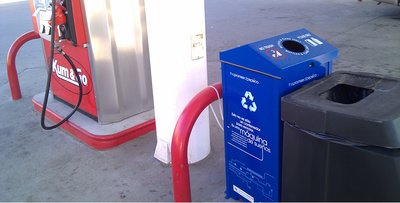 In rural locations with the Dream Machine™ we did not see any strong use of the reverse-vending machines, even with incentives. They worked great at grocery stores, because people spend more than three minutes shopping and have come to expect a recycling option there (often by law). PepsiCo did provide stationary bins at the pump. They were square metal bins, unlike our other pilot programs, but we still saw more usage there. So, we abandoned the automated machines at the store-front and had some consistency across all three programs.
In rural locations with the Dream Machine™ we did not see any strong use of the reverse-vending machines, even with incentives. They worked great at grocery stores, because people spend more than three minutes shopping and have come to expect a recycling option there (often by law). PepsiCo did provide stationary bins at the pump. They were square metal bins, unlike our other pilot programs, but we still saw more usage there. So, we abandoned the automated machines at the store-front and had some consistency across all three programs.
In 2012, we did two larger roll-outs. First, was a grant program to put recycling at-the-pump at every Des Moines, Iowa location – 39 stores. We changed the graphic wrap to be simpler and easier to read, and it was big hit. At the same time, PepsiCo wanted to split-test half of our 40 Tulsa locations to learn two things: (1) if they would see a bump in sales at recycling versus non-recycling locations, and (2) which pickup method worked better for them, back-hauling or distributor pickups. Our only stipulation was that PepsiCo Recycling switch to our bottle-shaped bins and use a simple, easy-to-read graphic wrap consistent with our other programs. They did, and it gave us another bump.
In 2013, another RAM jobs program with Community Intersections came online serving Colorado Springs, and PepsiCo expanded their Tulsa program with us to all 40 stores. That meant after three years Kum & Go had evolved from no recycling for customers at-the-pump to 112 stores having that option, which was 25% of all locations.
The push then became to work with our trash haulers across 11 states to secure single-stream recycling service. That was a prerequisite for any store to adopt the program we had designed. As I left the company in 2014 to become a consultant, PepsiCo was taking the recycling at-the-pump program we co-designed together across the country, partnering with as many c-stores as possible.
Lesson 1 – Location
The only place that was successful for placement of our recycling bin was at-the-pump. In the store, at the front door, and near the Redbox were all failures. Why? Because people were a captive audience at-the-pump and already in the mode of cleaning out their car if they had any trash. Walking to the store, inside the store, and getting a movie, people were already thinking about something else and not paying attention to their surroundings. The joke was, “If they could, our customers would open the door and push their trash out on the ground – so we might as well dig trenches they can drive over.” We didn’t, but you get the idea.
Go where people are. Don’t expect or require them to go out of their existing travel pattern to do the right thing – recycle. Design your program for ease-of-use. Don’t make them leave the room or even cross the sidewalk.
- Get a waste audit and ask a few questions of largest (weight/volume) waste streams.
- Where do these recyclables reach their end-of-use for students?
- Where are people going when the moment of litter-or-recycle arises?
- What corridors are their most likely path of travel, and which side will they be on?
- Place your bins there.
Lesson 2 – Adjacency
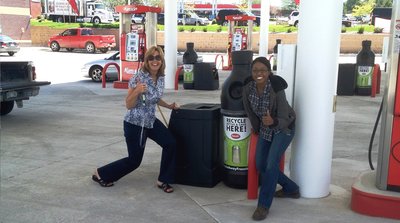 In our RAM first pilot in Greeley, we were seeing high contamination rates. We realized that in those locations we placed the recycling bin on the opposite side of the gas pump than the trash can. It wouldn’t make a big difference, right? Wrong. The sites where the recycling bin was placed right up next to the trash can had less than 3% contamination rates. We switched them immediately and the problem went away.
In our RAM first pilot in Greeley, we were seeing high contamination rates. We realized that in those locations we placed the recycling bin on the opposite side of the gas pump than the trash can. It wouldn’t make a big difference, right? Wrong. The sites where the recycling bin was placed right up next to the trash can had less than 3% contamination rates. We switched them immediately and the problem went away.
Make the choice convenient. Don’t expect or require them look in two different locations to get rid of something they don’t want. Put the recycling right next to the trash every time.
- If you have the location already selected from the first lesson, this one is simple.
- Put your bins next to each other.
Lesson 3 – Colors
We chose a specific bottle-shaped bin design that would catch peoples’ attention. Our trash bins varied from location to location, so we decided this route was easiest for us. We chose black because there were only two options from the vendor: (1) black, which was 100% from recycled bottles, and (2) gray, which was not recycled. On principle, we chose black, but we also knew we had a graphic wrap that we could utilize for colors and messaging.
Regardless, we asked our employees and customers about colors to understand their perception of recycling. What color did they associate with recycling bins? The vast majority was blue. Surprisingly, green, brown, and black were usually assumed to be trash. Yellow was rare, but sometimes associated with compost. So, for us, the blue design with PepsicCo worked well and we tried blue as our original design on the Iowa program, too. However, the sunlight faded the blue on paperboard quicker than most colors, so we changed to green for durability. Regardless, we always kept the trash black.
Use a strong contrast of the right colors. Keep the trash black if possible, and recycling blue or maybe green. Don’t depend only on signage to alert people to the difference – leverage colors.
- Go out on campus and ask, or survey students and faculty regarding their color associations.
- What color represents trash to them? Recycling? Compost?
- Buy your bins accordingly. If you already have mis-colored bins purchased, you can save money by painting them the appropriate color or using graphic wraps as cover up. Get creative!
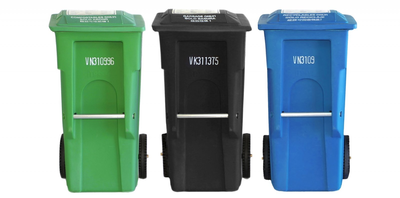
Lesson 4 – Graphics
Both initial graphic wraps, from RAM and from PepsiCo, were very busy and hard to read from a distance. When we redesigned them to have big, bold messages that our customers could see clearly (and read quickly) our usage went up and our contamination went down. We even added some extra signage right at the opening. Why? Because through observations and our own employees testing, we realized that the graphic wrap was only clearly visible from a distance as someone walked towards the bins. If they got out of their car very close to the bin, they might not read it easily without looking down. The opening was at eye level and a great chance to capture their attention.
Target your audience. Use large, bold, clear messaging on the side of the bin to reach people walking towards them. Use messaging at eye-level near the openings to reach people already standing near the bins.
- What options do we provide our campus – trash, recycling, and/or compost?
- Use big, bold words down the sides (aligned with the appropriate colors).
- Use smaller, eye-level words (and even examples of common items) at the openings.
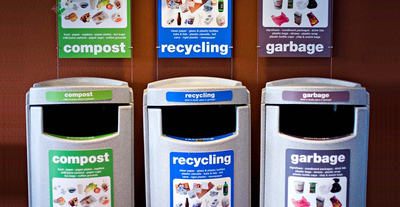
Lesson 5 – Openings
After we completed a waste audit, we found that the majority of what was being thrown away at-the-pump by our customers were cans and bottles. That was why the bottle-shaped bins had a small, round opening with a plastic cut-out that you had to push cans and bottles through. By design, people had to pause if their item did not naturally fit into the bin.
Use bin openings whose shape correlates with the type of item it receives. For example, cans and bottles usually go in a small, round hole. Paper-only is often a longer, narrow opening. Trash can be many things, but don’t make the opening too large, because it encourages people to do a walk-by toss which allows them to avoid all of our well-thought-out choices of color, message, and opening shape.
Design for a thoughtful pause. The bin openings are a physical way to alert people whether they are making the right choice. That last moment of consideration can be the difference between recycling and contamination.
- What options do we provide our campus – trash, recycling, and/or compost?
- What shape and size of openings is appropriate for that item?
Lesson 6 – Security
At our very first pilot in Ankeny, Iowa, I had the pleasure of watching video footage of a robbery. In amazement, I watched the choppy footage of a large moving truck pull in and start filling up with gas. The driver looked at our bin. He looked at it again. He looked around. Then, he picked it up and tossed it into the back of his truck and drove away. I couldn’t help but laugh out loud! That was not the response we were expecting from our customers.
RAM was already putting a sandbag in the bottom of each bin because wind was a problem. After the theft of our first bin, and then a wind storm in Des Moines that blew even the bins with one sandbag across the street, we ended up putting two sandbags in the bottom of every bin. In some locations, we even used zip ties and cable ties to secure the bins to a bollard, if there was one nearby.
Secure your bins. If they are heavy, or can be bolted to the ground, that’s great. But definitely consider sand bags, zip ties, or some other form of attachment so admirers don’t walk off with the recycling bins that you took so much time to design and install.
- What types of bins are we using? How heavy are they?
- Do they have a hook or hole that can be used to secure them with zip tie or cable?
- Can a sand bag or two be dropped in the bottom?
- Test a few options to see what works best for your environment.
Your Legacy Lives On
Last month, I was driving with my fiancé into Kansas City and we stopped for gas. The new PepsiCo Recycling bottle-shaped bins were there – a city we had never been in before. And I could see the graphic had continued to evolve for easier readability along the same lines as these lessons above. It just goes to show, that if you do your research and work to design programs for people that are easy-to-use, the small pebble you dropped in the pond will continue to ripple long after you’re gone.